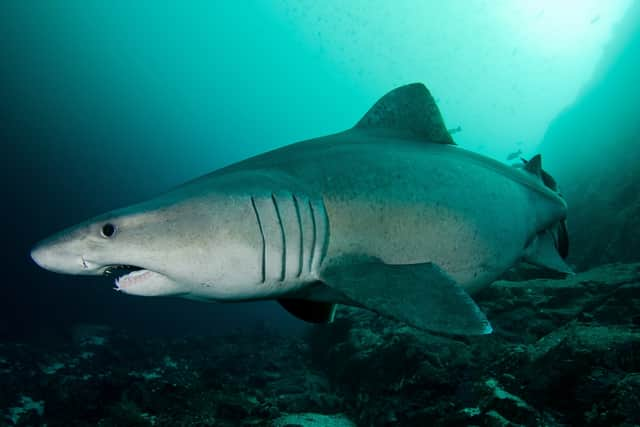Smalltooth sand tiger shark: climate change driving new 15-foot shark species to Britain's waters
and live on Freeview channel 276
A species of shark which can grow to more than four-and-a-half metres long has been found in UK waters not once, not twice, but three times this year - the farthest north it has ever been found.
On 18 March, David Curnick, a research fellow for the Zoological Society of London (ZSL), was texted pictures of what he suspected was a female smalltooth sand tiger shark washed up on a UK beach - a species that had never been recorded in the UK before.
Advertisement
Hide AdAdvertisement
Hide Ad"Questions were running through my mind - is this a hoax? Is the location accurate? Why has it turned up by the Isle of Wight?" he wrote in an article for ZSL's online blog.
Just two weeks later, Mr Curnick said the plot thickened when a second suspected female smalltooth sand tiger shark was found on the rocky shores of Wexford, Ireland - and this one was more than four metres long. Then on 1 May, a third smalltooth sand tiger shark was found, this time afloat in Lyme Bay on England’s southwest coast.


The ZSL research team's findings have now been published in the Journal of Fish Biology. Mr Curnick said not only was this a species that had never been found in Britain's waters, it had never been found this far north at all - with their usual stomping grounds more than 300 kilometres south, and thousands of feet beneath the waves.
Researchers suspect climate change is the culprit for their sudden appearance in the UK. "Smalltooth sand tiger sharks generally spend their time associated with the sea floor in warmer, more tropical waters. We therefore examined the sea bottom temperatures in the Celtic Sea and English Channel at the time of the strandings and in the months prior," Mr Curnick said.
Advertisement
Hide AdAdvertisement
Hide Ad"What we found was that the water temperatures in summer 2022 were considerably higher than the average for that time of year, and these conditions persisted into winter and through to 2023. We believe that these individuals followed the warming waters up and into UK and Irish waters."
Waters around the UK and Ireland have warmed in recent years due to climate change, and experts expect this will continue over years to come.
"As such, we suspect that this will likely not be the last smalltooth sand tiger shark that we see, with our waters becoming - at least temperature wise - more hospitable for the species," he said. "Considering 2023 is projected to be even warmer than 2022, we may have a busy few months ahead of us."
These latest findings also served as a warning, that other species may soon follow suit. "This highlights not only that we should be proactive in our response to managing new species, but the need to ask governments around the world to rapidly reduce carbon emissions."
Advertisement
Hide AdAdvertisement
Hide AdMr Curnick added that while "scaremongering" about the first shark on social media kicked off immediately, British beachgoers have nothing to fear from the species.
"Although at nearly [three metres] long, it was probably a larger shark than many people have ever seen - let alone found washed up on their doorstep - smalltooth sand tiger sharks feed on small fish, squid and shrimp, posing no risk to humans".
Comment Guidelines
National World encourages reader discussion on our stories. User feedback, insights and back-and-forth exchanges add a rich layer of context to reporting. Please review our Community Guidelines before commenting.
